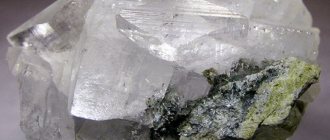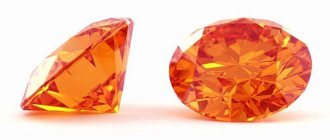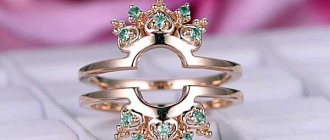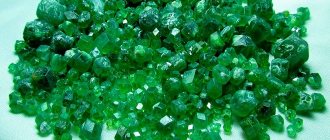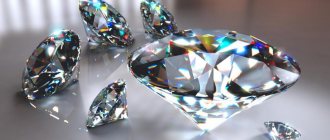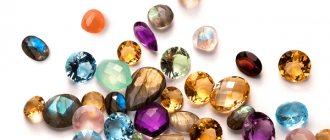History and origin
Throughout the history of civilization, the semi-precious lunar mineral has been an object of admiration, admiration, study, and use.
In the chronicles of different peoples, crystals are called petrified rays, the frozen light of the Moon. The Indians considered the mineral a symbol of passion and luck, a talisman that helps control destiny.
Moonstone
The mysterious shimmer of moonstone has given rise to legends about its origin:
- in Greece, a gem that allowed one to look into the future was considered a gift from the Hyperboreans;
- the moonlight stone was created by Satan for Eve to provoke greed;
- an ordinary pebble, polished by a luminary on a full moon, became a gem;
- the stone was mined by the Chaldean magicians;
- The Hindu gods Lakshmi and Vishnu received the crystal as a gift from the Moon.
Alexander the Great owned a ring with a gem; oriental healers used the magical properties of natural moonstone to preserve the youth of high-born clients. In Russia, the stone was known as “tausiny”, that is, “peacock” translated from Farsi.
The magical nature of the moonstone was not questioned; only exact sciences proved its earthly origin. The mineral is formed in pegmatites, alpine-type veins, and magmatic faults. Thanks to silver-gray, blue shades and shimmering tints, it looks like the Moon. It got its name from Mount Adula in the Swiss Alps, where it was first found by Europeans.
Other names for the mineral: adularia (in Europe), belomorite and selenite (Russia), fish eye (China), aglaurite, pearlspar.
Today the mineral is quite rare.
Variety of moon rocks
Adularia is called fisheye, aglaurite, ice spar, jandaracand, labradorite.
Varieties of lunar minerals:
- adularia - distinguished by bluish iridescence, mainly mined in India, but reserves of the mineral in the earth's crust are being depleted;
- Labradorite - has dark shimmering shades, the shimmer in the interior of the stone resembles a peacock feather.
- albite is a mineral with a milky white or grayish tint, which is obtained as a result of processing. The natural mineral has a yellowish color;
- sanidine - in appearance it looks like a frozen drop of liquid;
- selenite (from Latin “selenites”) – when light hits the stone, it sparkles with yellow highlights;
- Oligoclase is a rare gem with a pink tint; stones often contain golden inclusions.
Physicochemical properties of moonstone
The mineral is potassium aluminum silicate. Refers to the type of potassium feldspars. Family – orthoclases.
Transparent mineral
Chemical formula: K[AlSi3O8].
In nature, it occurs in the form of fragments of a prismatic or lamellar structure. In X-rays it exhibits a luminescent glow. In terms of density and hardness, it belongs to soft minerals with low wear resistance:
- hardness about 6 units on the Mohs scale;
- density about 2.5 g/cm3;
- colorless, but has yellowish and bluish tints;
- when the crystalline structure is destroyed by grinding, it turns into a white powder;
- has an uneven edge at the break;
- fragile;
- refractive index 1.525;
- stone system - monoclinic;
- The stone has perfect cleavage.
Natural appearance of moonstone
The special glow of adularia is called adularescence. The special refraction of light is provided by the lamellar structure, and the internal special pattern is provided by inclusions of volcanic inclusions in the mineral.
Physicochemical characteristics
Adularia is a translucent mineral, potassium feldspar. The spectacular glow, called adularization, is created by the thin-plate structure of the crystal. Semi-precious or ornamental stone. Looks like chalcedony or synthetic spinel.
| Formula | K[AlSi3O8] |
| Color | Colorless, yellow, light gray with a pale blue tint |
| Shine | Glass |
| Transparency | Translucent |
| Hardness | 6—6,5 |
| Cleavage | Perfect |
| Kink | Uneven, stepped |
| Density | 2.56—2.62 g/cm³ |
Product care
Mineral is a fragile material and jewelry is made by craftsmen carefully. It must be stored separately to prevent accidental scratches, chips, and mechanical damage.
Also read: Chalcopyrite - the magical and healing capabilities of the mineral
If treated with care, it will look like new for a long time. But, if while wearing the jewelry it has lost its shine and newness, it can be returned by polishing and polishing.
Varieties and colors
The term “natural lunar stone” refers to different types of quartz: amazonite (the so-called lunar green stone), belomorite, gypsum, selenite, labradorite, feldspar.
Kinds
But moonstones are minerals endowed with the property of opalescence. There are four varieties:
- Belomorit. Matte snow-white or milky-white translucent crystal with a bluish tint. Named after its location - the coast of the White Sea.
Belomorit - Adular. A yellowish transparent or translucent mineral, a type of orthoclase. Albite microinclusions, reflecting light, create a shimmering glow. Rare expensive look. The most valuable is with a bluish glow.
Adularia - Sanidin. The value depends on the color saturation. A rare, expensive look - blue specimens with a play of colors in 3D mode. Multi-color samples from India are cheap and available to everyone.
Sanidin - Labrador. Black crystal with an unusual play of shades. It was first found on the Canadian peninsula of the same name, then in other regions. Labrador in Russia is in the Khabarovsk Territory. Used as a facing material (at metro stations, for exterior decoration of buildings).
Labradorite stone
There are several types of Labrador:
- black moonstone - a dark specimen with blue and blue sparkles;
- sunstone - originally from the USA, with golden iridescence;
- spectrolite is a Finnish mineral with multi-colored tints.
Labradorite shimmers in different colors when the angle of light changes. Flashes and overflows are similar to the northern lights, a phenomenon called Labradorization.
Colors
Moonstone, unlike other minerals, does not have one shade. Rather, we are talking about the main color, which is complemented by multi-colored flashes, play, and radiance:
- white;
- lactic;
- colorless;
- lilac;
- black;
- light gray with a soft blue tint.
All types of natural moonstone with a cat's eye or "starry sky" effect on the surface are prized.
Ring with labradorite
How were gems formed? Moonstone (adularia),
About the magical moonstone: properties, description and who the gem of love is suitable for
Moonstone has long been shrouded in the legend of a curse. As if Satan tried to seduce the first people with the help of this gem, but they remained indifferent. And then he got angry and cursed the stone. But the idea that the mineral is cursed and brings bad luck is long outdated. And now this crystal is considered magical and healing.
What is adularia
Moonstone is a transparent, silver-gray or milky color mineral, distinguished from others by shimmering blue or white tints. Refers to semi-precious stones.
Moonstone looks like moonlight, which is why it got its name. Other names of the gem that can be found:
- fish eye;
- aglaurite;
- adularia;
- pearlspar;
- jandarakand.
Adularia, or moonstone, belongs to the group of potassium feldspars. Capable of iridescence (adularization) - internal glow. Thin stepped plates (lamellae) of albite, growing in the thickness of the mineral, cause its flickering.
Blue and golden tints arise due to interference - the refraction of light reflected from albite. If the plates are small, the glow effect will be similar to a cat's eye .
Varieties of Moonstone
Natural moonstone refers to varieties of quartz. There are many classification options; experts cannot come to a consensus. Main types:
- Belomorite - named after the place of extraction (White Sea). It has a matte snow-white or milky white color with a bluish tint, translucent.
- Adularia is a transparent or translucent yellow mineral, a type of orthoclase. Rare view. The most valuable is with a bluish tint.
- Sanidine is a blue moonstone with a three-dimensional iridescence.
- Labradorite is a black crystal found on the island of the same name.
- Amazonite is a green gem, a type of microcline.
The gem has different shades:
- white (from bright to milky);
- pink (from peach to lilac);
- yellowish;
- green;
- black;
- light gray with a blue tint.
The most valuable are gems with the effects of a cat's eye and starry sky, and rainbow tints.
For more information about some varieties of moonstone, see the review:
https://www.youtube.com/watch?time_continue=28&v=65BLHXbDeq4&feature=emb_logo
History and origin of the stone
The name “Adular” arose in honor of the Swiss Mount Adul, where the gem was first discovered.
Since the time of Adam and Eve, there has been a famous legend about the origin of the moonstone - adularia. The first people were drawn to beauty, admired the moon and the Gardens of Eden. Seeing this, Satan came up with a plan to create greed on earth. To do this, he scattered a gem that was more beautiful than the moon, and expected Adam and Eve to switch to it. But no. The moon was still more interesting to them. Then he got angry and cursed the stone.
There are other interesting stories:
- In the Middle Ages, alchemists studied the mineral. They laid it out in the moonlight in the hope that it would gain the coldness of the night moon.
- Ancient philologists believed that the stone was formed from the solidification of a moonbeam.
- Hindus revered the crystal, believing that it gave the gift of divination.
- In Arab countries, clothes were decorated with a gem, symbolizing a mineral with abundance and prosperity.
- Ancient Greek heroes used crystal to overcome difficult trials and defeat enemies.
- The people of Sri Lanka believed that whoever found the gem would be able to predict the future.
- In Ancient Rome, the gem was a symbol of romance and femininity.
- Witches loved moonstone. Before death, in cases where there was no one to give the gift, the witches enclosed it in a mineral.
- Chaldean magicians used moonstone to conduct clairvoyance sessions. They put it under their tongue, believing that it helps them see the future and opens the door to parallel worlds.
10. In 1868, W. Collins wrote a book about the moon rock.
11.In Peru there is a mysterious “Moonstone” of ideal shape. Pilgrims flock there to conduct meditations and rituals.
From a scientific point of view, moonstone was first discovered in Switzerland. It is known that it has been used by artisans and jewelers since the 19th century. And it was introduced into jewelry fashion in the 20th century by designer Rene Lalique.
How is moonstone mined and processed?
The most important countries in mining the mineral are Sri Lanka, Burma and India. The crystal is also mined in Lake Sevan in Armenia, on the Labrador Peninsula, the island of Madagascar, Mongolia, Tanzania, Australia, the USA, New and North Zealand. Deposits of moonstone in nature are found in quartz, alpine-type ore veins, and pegmatites.
The mineral is mined in Russia near St. Petersburg, on the White Sea coast, in the Baikal region, Siberia, the Irkutsk region, and in the Urals.
Sanded cabochon or in the form of flat inserts. The untreated mineral is fragile and crumbles under any impact. Therefore, jewelers are reluctant to work with it.
How to distinguish a real moonstone from a fake
There are fakes made from jewelry and ornamental materials and glass. Good imitations are now produced in India from tinted translucent glass.
- A true crystal has a blue luster with no greenish or brownish tints.
- The mineral should have a glassy luster, be free of foreign inclusions, and be translucent or slightly opaque.
- The original may have minor internal defects (cracks, bubbles), it will not be perfect.
- When a real mineral is rotated, color shifts are visible, which the imitation does not have.
- The fake quickly heats up in your hands, while the original remains cool for a long time.
- In water, the original becomes brighter, but the imitation does not change in any way.
- A low price can indirectly indicate imitation.
When purchasing, give preference to trusted stores with well-known names. There you can always ask for supporting documents indicating the authenticity of the mineral.
We recommend watching an interesting review about how to distinguish real minerals:
Properties and uses of the mineral
The stone is the personification of moonlight. Its properties intensify during the waxing and full moon and decrease during the new moon, to the point that they can take energy away from the wearer.
The gem has found its application in jewelry, because it is inexpensive, but looks impressive, which allows jewelers to reduce the price of products.
The mineral is used to decorate the interior and exterior of buildings, furniture elements and other luxury decor.
Physical properties
Moonstone is sensitive to mechanical damage and is fragile. It has a columnar, prismatic, tabular structure.
Physico-chemical properties of the gem:
- Chemical formula: K[AlSi3O8].
- Color: colorless, milky, grayish, yellowish with a blue tint.
- Transparency: translucent, translucent.
- Gloss: glassy.
- Syngony: monoclinic.
- Fracture: uneven, stepped.
- Cleavage: perfect.
- Hardness: 6.5 on the Mohs mineralogical scale.
- Density: 2.57 g/cm3.
10.Refractive index: 1.525.
11.Luminesces in X-rays.
In addition to the topic about the properties of stone, watch the video:
Medicinal properties
People believe that the mineral helps in the treatment and prevention of many diseases.
Moon rock:
- normalizes sleep, relieves nightmares and insomnia;
- relieves anxiety, increases resistance to stress;
- stabilizes the nervous system;
- removes toxins and excess water, improving metabolic processes in the body;
- improves the functioning of the liver and pancreas;
- relieves pain, especially effective during childbirth;
- promotes concentration;
- accelerates recovery of the genitourinary system after inflammation;
- restores hormonal levels;
- improves the functioning of the cardiovascular system;
- rejuvenates.
Magical properties of moonstone
The mineral has long been no longer considered cursed, and can only harm capricious people at most, exacerbating this quality. In any case, when wearing a moonstone, listen to the sensations and analyze your relationships with loved ones. If you notice deterioration, then discard the gem.
The following magical properties are attributed to the gem:
- helps in gambling, in risky matters, for example, when doing business;
- increases attractiveness in the eyes of the opposite sex;
- protects against black magic;
- enhances the ability to persuade and oratory;
- relieves melancholic mood and suicidal thoughts;
- gives love for the great, the noble, reveals talents;
- changes color if danger threatens;
- enhances tender and passionate feelings in love relationships;
- helps you find your soulmate;
- fades if love has passed;
- gives wisdom, prudence;
- prevents conflicts and anger;
- preserves maiden honor, protects marriage from betrayal, preventing an outburst of passion;
- develops extrasensory abilities.
Moonstone will become a talisman for travelers. Amulets are suitable for melancholic, shy people who are often worried and sad, prone to mood swings. Amulets help pregnant women and women in labor well.
As a talisman it is suitable for strong, confident people with a strong-willed character and aspirations to achieve goals. These are people by profession: businessman, journalist, actor, writer, professor, musician, artist.
A silver frame will help enhance the magical properties of the talisman. As well as contact with skin. If it is not possible to wear the product close to your body, then you need to touch it at least several times a day.
To attract the opposite sex, it is recommended to wear an amulet with a moonstone. And to attract a certain personality, you can give jewelry with a gem. A ring with a stone on your left hand will help you avoid conflicts and misunderstandings. A ring on your right hand will develop intuition and help you relax.
The energy of the mineral is maximum during and around the full moon. During the new moon, it is better to discard the stone in order to avoid a decline in energy balance.
Most effective for people born on a full moon or Monday. The crystal will guide such people on the right path to happiness and smooth out obstacles on the way to their goal.
Moonstone goes well with other gems: quartz, garnet, obsidian, crystal, pearl, topaz, jasper, agate.
A must-watch video review on this topic:
Who is the stone suitable for according to their zodiac sign and name?
Some astrologers advise Capricorns to abandon the moonstone and believe that the mineral will not have any effect on Sagittarius and Leo. According to other opinions, the gem is not recommended for Pisces, Aquarius, and Aries. Therefore, be sure to listen to your personal feelings. If there are changes for the worse, stop wearing the gem.
It is believed that thanks to the moonstone:
- Gemini will get rid of mood swings.
- Aquarians will stop being stubborn and protect themselves from envious people.
- Libras are realized in creativity, will reveal personal potential, will find peace of mind, harmony and peace.
- Cancers will become less anxious, lazier and more passive.
- Leos will become more confident, calmer, and their ambition will be smoothed out.
- Sagittarius will be able to solve problems and find a way out of a deadlock situation.
These qualities will be more pronounced in women. For men, the emphasis will be on strong-willed and achievement qualities: career growth, material well-being, achieving goals. Cancer men, thanks to the moonstone, will smooth out their difficult character, become healthier, and gain vitality. For Cancer men, the gem will add charm, which will attract the attention of women.
The gem will help all zodiac signs in studies, career growth, and communication with people.
Combines with the names: Raisa, Elena, Evdokia, Avdotya, Gleb, Igor.
Why do you dream about moonstone?
According to the dream book, a moonstone dreams of a quick trip or the appearance of a lover. The dream usually means flexibility, impending changes, impermanence.
Jewelry and how to wear moonstone correctly
Rings, rings, earrings, necklaces, pendants, beads, bracelets, and brooches are made from gemstones. They highlight the beauty with a silver frame. It is recommended to wear jewelry to social events.
It is desirable that the gem is in contact with the body of the wearer.
Moonstone can be worn not only by women, but also by men. This will emphasize their courageous qualities, determination, and desire to achieve goals.
Caring for stone and products
To prevent the crystal from losing its shine or fading, protect it from direct sunlight, high temperatures, and chemical influences. Protect the stone from falling, as dents and scratches may appear.
Store the gem in a softly padded box or bag separately from other jewelry.
Warm soapy water is suitable for cleaning. Dry with a soft cloth, blotting gently. Do not use aggressive detergents, hard brushes, or metal sponges, as this will damage the mineral.
Repeated grinding and polishing by a jeweler will help to completely restore the original appearance.
Mineral cost
The lowest cost is for multi-color samples from India: from 1 dollar per carat. The cost of larger ones depends on the purity of the color, about $70 per carat.
The most expensive are blue crystals with a rainbow tricolor depth, their prices start at $500.
Jewelry with a moonstone framed in regular metal costs from 550 rubles, in a silver frame from 1200 rubles.
It is recommended to buy a classic gem on the 2nd lunar day, and start wearing it after 2 weeks, when the crystal gets used to its new owner.
Medicinal properties
Like the Moon, the influence of moonstone on a person is focused on the psyche:
- it is a sedative that neutralizes the causes of psychosis and fear;
- a stone at the head of the head or under the pillow will drive away disturbing thoughts and restore restful sleep;
- has a beneficial effect on brain function, especially the pituitary gland;
- relieves attacks of epilepsy;
- calms hyperactive children;
- curbs sudden outbursts of anger;
- relieves chronic depression, mental fatigue, and depressed mood.
To stop the psycho-emotional “swing”, a raw moonstone or jewelry closer to the body is suitable. This is especially true for people who live “on the Moon”, in accordance with the phases of the star.
The stone of the water element solves problems with body fluids. Has a beneficial effect on the following systems and organs:
- genitourinary system;
- Gastrointestinal tract;
- kidneys, liver, bile ducts;
- heart, blood vessels; improves blood circulation.
You can treat with a gem from a distance: just place the energetically purified adularia on a photograph of a person. They say that during the full moon healing dew appears on the stone.
Selenite is considered the best gem for a woman. Jewelry makes the hostess confident, charming and energetic. The husband gives a ring and/or earrings to his wife, who is prone to hysterics. Lithotherapists advise women with a difficult pregnancy or who are afraid of the upcoming birth to acquire products with moonstone.
Magic properties
According to people, the magical properties of the stone, shimmering like the Moon, were bestowed by the luminary itself.
Legends about the stone
Adularia is endowed with mystical properties, there are legends about it. Indian legends say that jandarakand is frozen moonlight (literally translated from Sanskrit - moonlight).
Set of jewelry with adularia
In Ceylon it is still considered sacred today. Anyone to whom the mineral allowed itself to be found became a clairvoyant. Temple servants claim that a stone lying in the darkness of the monastery releases “lunar dew” - a magically powerful substance.
Areas of influence
Moon crystal is present in occult rituals and secular life.
Magic
Moon worshipers in India use the gem in accordance with the lunar phases. Adherents of Hinduism use it on the chakras.
Sorcerers and alchemists value the magical properties of the volatile moonstone, respect it, but are afraid of it. Some people place a crystal under their tongue at night to make the divination come true. Others fear that the stone's magic will take away their superpowers.
Selenite is a favorite of mystics. Meditations are carried out while holding a crystal in the mouth. The process is more effective when the Moon is in the zodiac sign of the owner. A gem under the pillow will bring about a prophetic dream.
Love
For the Western world, adularia has the meaning of a love “magnet”. If you wear it near your heart or on the left side (for example, a brooch), you will soon find your soulmate. Or attention will be attracted. The owner of selenite does not know the torment of unrequited love.
Selenite bracelet
With the help of a stone you can check compatibility with the object of passion. The crystal is placed on a photograph of a person. Tarnishing of the gem means that it is not worth fighting for love. If the radiance is preserved, the feeling will be strong and long lasting.
Creation
Amulets with lunar inserts are an attribute of extraordinary creative people. The crystal will help you unlock your personal potential or realize your plans. Selenite awakens a craving for beauty and makes a person an esthete. Talents that the owner did not even suspect about may awaken. To secure them, wear a ring or place a stone on a personal photo or in your pocket.
Business
The energy of the mineral will help win over business partners during negotiations. Astrologers advise wearing a pendant with a zodiac sign, a ring or a bracelet on your right hand. And the matter begins on the waxing Moon.
Selenite is an “assistant” of card players and sharpers.
Talismans and amulets
Any jewelry with a moon crystal are talismans and amulets that help the owner in their own way:
- a ring, ring or bracelet on the left hand will adjust the mood and help avoid conflicts when communicating with ill-wishers;
- an accessory on the right hand will develop talents and intuition;
- decoration will make the owner more tolerant and merciful.
The influence of adularia intensifies with the growth of the lunar crescent, reaching a maximum at the full moon.
Areas of application of moonstone
Today, jewelry is successfully made from adularia: keychains, amulets, rings, bracelets, pendants. The mineral is very fragile; in order to increase the strength of the stone in jewelry, after polishing it is treated with a cabochon.
Adularia jewelry
Silver is used as a setting for the moonstone. It is believed that delicate shimmers look more advantageous against the background of this metal. Although, depending on the color of the stone, gold can also be used as a setting. In famous brands, yellowish minerals or labradorite are usually inserted into gold jewelry.
Thanks to its plate-like structure, jewelers use adularia to inlay weapons, jewelry boxes or hair accessories. Its softness allows craftsmen to carve miniature figurines from it. They are often used not for decoration, but for magical rituals.
Magical properties of moonstone
In the East, even today, moonstone is considered a love talisman.
Using its magical properties, you can increase the fertility of all living things.
It is believed that a silver frame significantly enhances the magical properties of the stone. Especially during certain phases of the moon. It is recommended to wear the mineral directly on the body; it is not advisable to put it on top of clothes.
Magicians use moonstone to enhance their own abilities. It is believed that during the growth of the Moon it adds magical power to the owner. Ordinary people use it to protect themselves from evil spells. It has the ability to accumulate and take on all the negative energy directed at its owner.
It is recommended as a powerful love talisman that can attract the attention of the object of love. Often, jewelry with adularia is worn by unmarried girls, hoping to find a couple with its help.
It is believed that the metaphysical properties of the mineral depend on the phases of the moon. Adularia becomes maximally active during the full moon, but it is better not to wear the stone on the waning moon. It goes into a state of rest and is able to feed on the owner’s energy.
For people with artistic talents, the stone will help attract inspiration and sharpen their perception of the world. But it also serves as a talisman for gamblers and swindlers, attracting good luck to their side.
Adular is able to change the owner’s character, pacifying his aggression and awakening the best qualities of his character.
Therapeutic capabilities of adularia
The famous physician Avicenna described the use of adularia in medical practice for the treatment of many diseases. He dosed the patient with ground stone powder. In ancient times, it was worn around the neck of women in labor, believing that it helped labor.
It is believed that the mineral can heal only through contact with the body. He must stay with the person throughout the entire course of treatment for any disease.
Adularia affects nerve fibers and relieves tension. This normalizes sleep, allows you to get rid of internal fears, and avoid panic attacks. It is used as an amulet in stressful situations in the hope that it will help maintain cool blood and clarity of mind. This feature of the stone is used by students when taking exams.
Adularia enhances the capabilities of all living things for restoration and harmony, strengthens the immune system, so it is recommended to be worn by women and men over 35 years of age to normalize hormonal levels.
Ancient doctors believed that the stone was able to purify the blood, which normalized blood circulation and lowered blood pressure.
Who is suitable according to their zodiac sign?
Astrologers agree that according to their zodiac sign, adularia is suitable for representatives of the water element. This is a good luck talisman that awakens talents. Aries and Capricorn will slow down their development and attract problems. Suitable according to the horoscope for those born on a full moon, especially on Monday (moon day).
The magical capabilities of the lunar gem are felt by all inhabitants of the zodiac circle.
| Zodiac sign | Compatibility (“+++” – fits perfectly, “+” – can be worn, “-” – strictly contraindicated) |
| Aries | — |
| Taurus | + |
| Twins | + |
| Cancer | +++ |
| a lion | + |
| Virgo | + |
| Scales | + |
| Scorpion | +++ |
| Sagittarius | + |
| Capricorn | — |
| Aquarius | + |
| Fish | +++ |
(“+++” – fits perfectly, “+” – can be worn, “-” – is strictly contraindicated)
Compatibility with other stones
For a mineral of the water element, a combination in jewelry or attire with stones of Fire and Air is excluded. In the first option, they will destroy each other, in the second, they will create vibrations that are unpleasant for sensitive natures.
Ring with adularia and white pearls
Adularia is combined with white pearls, coral, amethyst, onyx, obsidian, and amber. Zero compatibility with ruby, agate, malachite, jasper.
Where is it used?
Semi-precious adularia is a sought-after jewelry and decorative material.
Jewelry
Bracelets, rings, earrings, and necklaces are made with moon crystal. The frame is silver; options in gold or platinum are often ordered individually. The iridescent mineral is treated with a cabochon, which emphasizes the tenderness and smoothness of the play.
Decor
A hundred years ago, the beauty of moonstone was appreciated by the master of French jewelry fashion, Rene Lalique. Today the number one decorative and ornamental material is labradorite. Relatively soft stone is loved by stone cutters who create small plastic pieces.
Amulet with labradorite stone
Large deposits have made it a favorite in finishing pompous interiors and exteriors of private or public buildings. It is used to make countertops, furniture elements, and other luxury decor.
Price
The price of a moonstone is determined by size, variety, degree of transparency, and color saturation.
The order of prices is as follows (per carat):
- multi-color Indian gem: weighing up to 1 carat - $2-31, 3-5 carats - $80-350;
- Labradorite - $12–15 ($60–75 per gram);
- “rainbow” (transparent with a rare play of reflections) - from $100;
- blue Sri Lankan - from $500.
The cost of jewelry with an adularia made of ordinary metal is 550-700, in silver - from 1200 rubles.
Adular - Ancient magic
The translucent shimmering mineral has attracted attention since ancient times. At different times, healers, alchemists and sorcerers attributed a variety of properties to the stone, sometimes magical and supernatural.
Moonstone has always been considered sacred in India, where it was first discovered. It is present in ancient Indian legends as a symbol of love and family happiness. Moonstone jewelry is a traditional Indian wedding gift. Here the mineral is called jandarakand, which means “moonlight.”
Adular moonstone
The ancient Chaldeans, who lived in Southern Mesopotamia several thousand years before our era, treated moonstone with respect. They believed that the stone revealed the hidden capabilities of a person. It was believed that during the full moon the magical properties of the stone intensified. It was at this time that special rituals were performed. The ancient Chaldean priests, by placing a stone under their tongue on the full moon, acquired the gift of prophecy.
The ancient Romans were also fascinated by the mysterious beauty of the mineral. They believed that the stone represented frozen moonlight. It was used to make exquisite jewelry.
The outstanding Persian physician Avicenna, who lived at the turn of the 10th – 11th centuries, mentions moonstone in his works as a miraculous remedy that can cure many ailments.
In medieval Europe, the stone was considered a talisman of love. Lovers gave jewelry with it to each other. The tarnished mineral meant that mutual feelings had also faded.
In medieval England, they believed that the talisman endowed the owner with the talents of eloquence and persuasion, and also attracted good luck. The latter quality made the stone extremely popular among card sharpers.
In the 18th-19th centuries, the moonstone seemed to be forgotten. But a new triumph awaited him. At the end of the 19th and beginning of the 20th centuries, during the heyday of the Art Nouveau style, moonstone jewelry came back into fashion thanks to the French jeweler Rene Lalique. Today, these exquisite works of jewelry are kept in museums and private collections.
How to spot a fake
Deposits are being depleted, so imitations are often offered instead of selenite.
The description and characteristics of a natural mineral help to establish the origin and distinguish it from a fake:
- Silky surface with small defects (grooves, chips, chips), microvoids or bubbles inside, inherent in many natural minerals.
- Glare and iridescence of color when turning the stone under the rays of the sun.
- If you look at the natural mineral directly, the blue reflection is not visible (only at an angle of 15–20°). Glass or other fake materials do not produce a blue reflection.
- Transparency or translucency, purple or blue tints.
- Water helps to identify a real gem: in it the stone becomes brighter.
- Under X-rays, real stone luminesces.
Unlike a fake, a natural mineral lacks rich color and shine, and heats up slowly in the hands.
Where is it mined?
Moonstone appears in ore, most often gold-bearing, veins or in pematites.
It was found in a quartz vein of the Alps in places where there is also ilmenite, rock crystal, titanite, chlorite, hematite and rutile. It is formed in igneous rock at a temperature of 650–700 °C. Adularia can also grow in hot water rich in potassium and silica. It is formed in rock (or rather, in its cracks), including effusive volcanic rock. Feldspar was first discovered in the Adula Mountains. Many believe that this is where the second name came from – adularia. However, there is a version that it was named in honor of Mons Adular (as the St. Gotthard massif was previously called). Today, Sri Lanka has almost exhausted the deposit. Rich reserves are found in:
- Brazil.
- Australia, Burma and India (here is a mineral that has a star effect).
- Madagascar.
- New Zealand.
- USA. Near Oliver, adularia has been mined since 1958, which is similar in quality to stone from Sri Lanka.
- Tanzania (Africa).
- Russia.
- Ukraine.
In the Russian Empire, unprocessed moonstone was found in the Urals (namely in Mount Mokrusha), in the Inaglinsky massif, which is located in Siberia. The gem was discovered near a quartz deposit. Chukotka is famous for its minerals: adularia-quartz (it has a banded-cocard texture) and adularia-rhodochrosite (it includes native gold and quartz).
On topic: How to distinguish a real moonstone from a fake
Spar brushes are found in the Baltic states. Also here you can find single growths and small crystals.
Spar, which also includes pegmatite, is mined in Irkutsk (Olkhonsky and Slyudyansky districts). Moreover, the sizes of the crystals are different: the Olkhon ones are 10–20 cm larger than the Slyudyansky ones. True, the mineral from these deposits has disadvantages: iridescence occurs with a pale effect, there are many cracks in it, and it is ferruginous.
The richest country in moonstone deposits is Ukraine. Here the mineral is mined in such quantities that it has been transferred from semi-precious to the finishing category.
How to wear and care
Natural stone is vulnerable and its processing requires skill and care. The same is true for everyday use.
Jewelry with labradorite stone
Care
Over time, jewelry inserts fade. The darkened crystal is wiped with velvet cloth. The shine will be restored by the jeweler in the workshop by re-grinding and polishing the stone.
It is better to store the products separately so that other stones or the setting do not scratch them.
The gem is recharged by placing it on the lunar “path” overnight.
Wearing
If a pebble is perceived as magical, the following features are taken into account when wearing it:
- For jewelry with a moonstone, the best setting is silver; proximity to other minerals is taboo.
- It is better for sociopaths, evil silent people, people with uncontrollable aggressiveness to refuse moonstone - these qualities will worsen. But shy people prone to melancholy or depression benefit from blue crystal.
Selenite is a stone that shares energy with the owner during the waxing moon until the full moon. But on the waning moon he becomes an energy vampire. It is advisable for jewelry lovers to take this into account.
- This is the mineral of self-sufficient people who know what they want and how to achieve it.
- In order for the stone's ability to heal the owner to be activated, it must come into contact with the body, and not with clothing.
- Jewelry with adularia is appropriate for important events; a gift with this stone is considered elite.
Pendant with selenite
To make your cherished wish come true, you need to wait for a moonlit night, take the pebble in your left hand, stand on the lunar path or under the light of the moon (you can in the room). And clearly say what you want so that the stone can “hear.”
Jewelry with mineral
According to legend, a piece of the Moon that fell to Earth brought with it its power, so people began to wear jewelry to protect their owners. The gem began to be actively used in jewelry production at the beginning of the twentieth century with the light hand of the trendsetter, the French designer Rene Lalique.
The gem is very delicate and fragile. It is necessary to protect the decoration from mechanical damage . They shine with a soft glow from the very depths, shimmering with white and blue shine. It's hard to take your eyes off them. Various decorations are made from the mineral:
- brooches;
- rings;
- earrings;
- bracelets;
- pendants;
- necklace;
- beads
The gem is combined with many semi-precious, precious and ornamental stones:
- pomegranate;
- quartz;
- obsidian;
- crystal;
- pearls;
- agate;
- topaz;
- jasper.
The price of adularia and varieties vary depending on the stone and frame. Jewelry with a stone can be purchased from 200 rubles. For the same ring with a Labradorite, you will have to pay 5–10 times more. Jewelers work with it very carefully because of its fragility. The owner must treat it with the same care so that the jewelry retains its natural beauty for a long time.
Also read: Epidote - a representative of the magical world of ornamental stones
Favorable time to buy
A lunar gem will not only be a decoration, but also a magical assistant and doctor if it is bought, brought into the house and started to be used on a certain lunar day:
| Type of stone | Purchase (lunar day) | Beginning of use (lunar day) |
| adularia | 2 | 16 |
| Labrador | 5 | 19 |
| selenite | 13 | 27 |
| belomorite | 14 | 28 |
Stone likes communication, and in two weeks you can establish contact with him. That is, to consult, talk about your affairs or problems, thank for the help, admire, admire its beauty.
